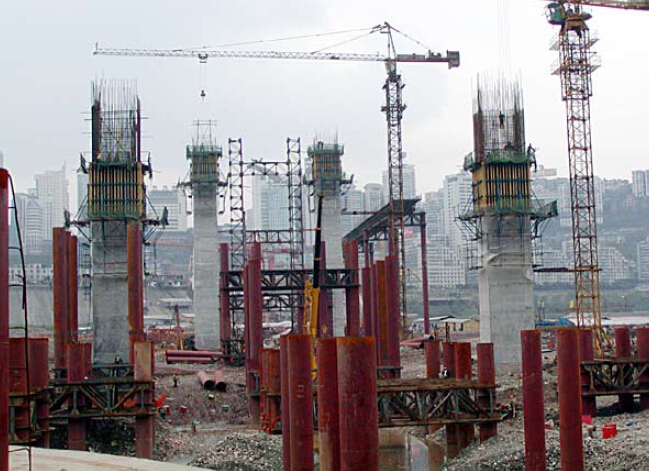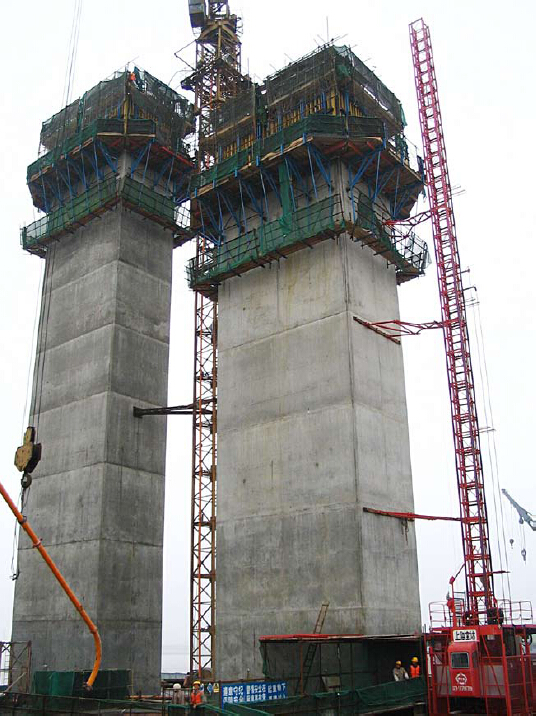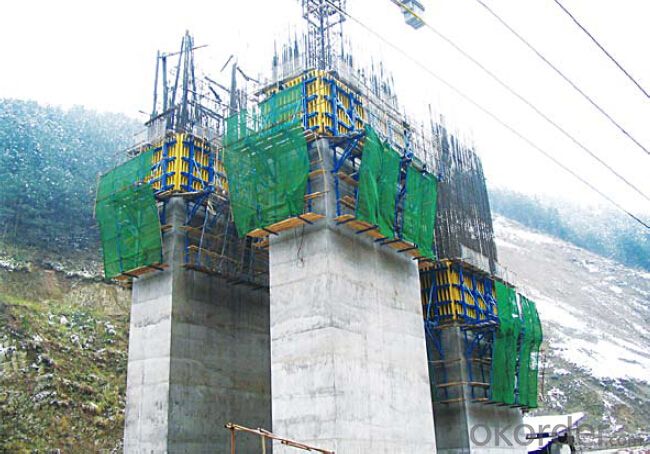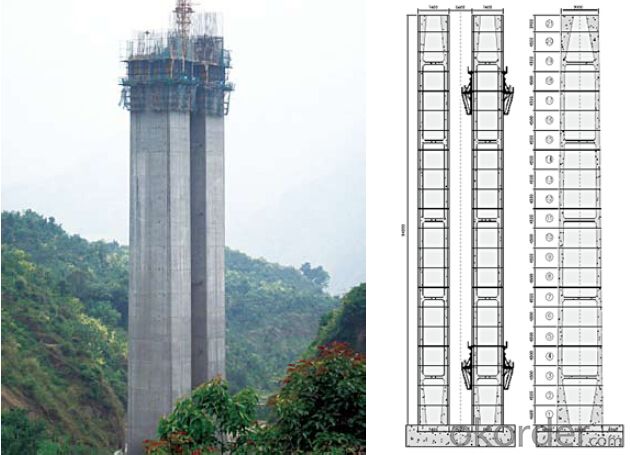Climbing bracket CB240 for formwork and scaffolding system
- Loading Port:
- Tianjin
- Payment Terms:
- TT OR LC
- Min Order Qty:
- 50 m²
- Supply Capability:
- 1000 m²/month
OKorder Service Pledge
OKorder Financial Service
You Might Also Like
Climbing Bracket CB240 & CB210
They are framework brackets for supporting large-area wall formwork.
Typical applications for the CB240&CB210 are pier and column/shear wall/core walll/ in the
building.
CB210 has smaller size than CB240, it will be cost effective in some condition.
Characteristics:
◆ High bearing capacity
The high loading capacity of the brackets allow very large scaffold units. This saves the number
anchor points required as well as reducing climbing times.
◆ Simple moving procedure by crane
Through the strong connection of formwork together with the climbing scaffold, both can be moved
as a single climbing unit by crane. Thus valuable time-savings can be achieved.
◆ Fast striking process without a crane
With the retrusive set, large formwork elements can also be retracted quickly and a minimum of
effort.
◆ Safe with work platform
The platforms have assembled firmly with bracket and will be climbing together, without scaffolding
but can work safely in spite of your high location.


- Q: What types of structures can be built using steel formwork?
- Steel formwork can be used to construct various types of structures, including but not limited to reinforced concrete walls, columns, beams, slabs, staircases, tunnels, and bridges.
- Q: Can steel formwork be easily modified or adjusted during construction?
- Yes, steel formwork can be easily modified or adjusted during construction. Steel formwork is known for its flexibility and adaptability, allowing for quick and convenient adjustments as per the project requirements. Steel formwork systems are designed to be modular, which means they can be easily assembled and disassembled, allowing for easy modification or adjustment of the formwork structure. Additionally, steel formwork can be easily cut, welded, or bolted together to create custom formwork shapes or sizes. This versatility of steel formwork makes it a preferred choice in construction projects where modifications or adjustments are frequently required.
- Q: How does steel formwork perform in different weather conditions?
- Steel formwork is known for its durability and strength, making it a popular choice for construction projects in various weather conditions. In general, steel formwork performs exceptionally well in different weather conditions, including extreme heat, cold, and wet conditions. In hot weather conditions, steel formwork demonstrates high resistance to warping and deformation. It retains its shape and structural integrity, ensuring that the concrete is poured accurately and uniformly. The thermal conductivity of steel also helps dissipate heat quickly, preventing any potential damage due to expansion or contraction. Similarly, steel formwork performs reliably in cold weather conditions. It does not become brittle or lose its strength, ensuring the stability and safety of the construction. The low coefficient of thermal expansion of steel prevents any significant changes in dimensions, ensuring that the formwork remains intact and solid. When it comes to wet weather conditions, steel formwork exhibits excellent resistance to moisture. It is not susceptible to rot or decay, unlike wooden formwork. This makes it ideal for projects in regions with high humidity or frequent rainfall. Additionally, the smooth surface of steel formwork prevents water absorption, reducing the risk of concrete spalling or cracks caused by water ingress. Furthermore, steel formwork is highly resistant to corrosion, making it suitable for coastal areas or places with high levels of air pollution. Its protective coating prevents rusting and ensures a long lifespan, even in harsh weather conditions. Overall, steel formwork is a reliable and versatile choice that can withstand different weather conditions. Its strength, durability, resistance to temperature changes, and moisture make it an excellent option for construction projects, providing stability, safety, and longevity.
- Q: Can steel formwork be used for concrete structures in corrosive environments?
- Steel formwork can be used for concrete structures in corrosive environments, but special precautions need to be taken to ensure its durability and longevity. Corrosive environments, such as those with high levels of moisture or exposure to chemicals, can cause steel to rust and deteriorate over time. To mitigate this risk, the steel formwork should be properly coated with corrosion-resistant materials, such as epoxy or galvanized coatings, to provide a protective barrier against the corrosive elements. Regular maintenance and inspections should also be carried out to identify and address any signs of corrosion or damage. Additionally, alternative formwork materials, such as plastic or fiber-reinforced polymers, may be more suitable for extremely corrosive environments as they offer superior resistance to corrosion. Ultimately, the decision to use steel formwork in a corrosive environment should be based on thorough evaluation of the specific conditions and the implementation of appropriate preventive measures to ensure the long-term durability of the concrete structure.
- Q: Can steel formwork be used for energy-efficient concrete buildings?
- Yes, steel formwork can be used for energy-efficient concrete buildings. Steel formwork provides excellent strength and durability, allowing for the construction of complex concrete structures with high thermal performance. Additionally, steel formwork can be easily reused multiple times, reducing waste and promoting sustainability in the construction industry.
- Q: What are the different types of formwork ties used in steel formwork?
- There are several different types of formwork ties that are commonly used in steel formwork systems. These ties are essential for holding the formwork panels together and ensuring the stability and strength of the formwork structure. 1. Wedge Tie: This is the most common type of formwork tie used in steel formwork. It consists of a wedge-shaped metal piece that is inserted into a hole in the formwork panel. The wedge is then tightened, creating a strong connection and holding the panels in place. 2. Pin and Wedge Tie: This type of tie consists of a pin and a wedge. The pin is inserted into a hole in the formwork panel and then the wedge is driven into the pin, creating a tight connection. 3. Wing Nut and Tie Rod: This tie system uses a wing nut and a tie rod to hold the formwork panels together. The tie rod is threaded through the panels and secured with a wing nut on each side. This type of tie allows for easy removal and reassembly of the formwork. 4. Coil Tie: A coil tie is a type of tie that is used when the formwork panels need to be secured to the steel reinforcement bars. The tie is threaded through the formwork panel and then wrapped around the reinforcement bar, creating a secure connection. 5. Flat Tie: Flat ties are used to connect the formwork panels in situations where the panels need to be secured tightly against each other. These ties are flat metal strips that are inserted into holes in the formwork panels and then tightened. These are just a few examples of the different types of formwork ties used in steel formwork systems. The choice of tie will depend on factors such as the specific formwork design, the load requirements, and the ease of installation and removal. It is important to select the appropriate tie system to ensure the stability and safety of the formwork structure.
- Q: How does steel formwork handle different concrete finishing techniques?
- Steel formwork is highly versatile and can handle a wide range of concrete finishing techniques. Its strength and durability allow it to withstand the pressure and forces exerted during various finishing processes. For smooth finishes, steel formwork provides a solid and stable surface that allows concrete to be poured and leveled easily. The rigidity of steel formwork ensures that the concrete remains in place and does not sag or deform during the finishing process. This enables the concrete to be smoothly troweled, resulting in a polished and uniform surface. Steel formwork also accommodates textured finishes. It can be designed with various patterns and textures to create unique and decorative concrete surfaces. By using steel formwork with specific designs, such as corrugated or embossed patterns, the concrete can be poured to replicate these designs, resulting in visually appealing textured finishes. In addition, steel formwork is capable of handling exposed aggregate finishes. Exposed aggregate is a technique where the top layer of concrete is removed to reveal the underlying aggregate stones, creating a decorative effect. Steel formwork can be designed with removable panels or inserts that allow the concrete to be poured in a way that exposes the desired amount of aggregate. These removable panels can be easily taken off after the concrete has cured, revealing the desired exposed aggregate finish. Furthermore, steel formwork can also accommodate stamped concrete finishes. Stamped concrete is a technique where patterns or textures are imprinted onto the surface of the concrete using specialized stamps. Steel formwork provides a solid base for the stamps to be pressed onto, ensuring accurate and consistent imprints. The rigidity of steel formwork prevents the concrete from shifting or deforming during the stamping process, resulting in precise and high-quality stamped finishes. Overall, steel formwork is compatible with various concrete finishing techniques. Its strength, stability, and versatility make it an ideal choice for handling different finishing processes, allowing for the creation of smooth, textured, exposed aggregate, and stamped concrete finishes with precision and ease.
- Q: Are there any specific considerations for using steel formwork in areas with high traffic loads?
- There are various factors to take into account when using steel formwork in areas with high traffic loads. Firstly, it is crucial to carefully assess the strength and durability of the steel formwork to ensure it can withstand the heavy loads and constant traffic. Steel formwork is renowned for its robustness and load-bearing capacity, making it suitable for such applications. However, it is important to select the appropriate type and grade of steel that can endure the specific traffic loads in the area. Secondly, it is imperative to entrust the design and construction of the formwork system to experienced professionals who understand the requirements of high traffic loads. Adequate reinforcement and bracing should be incorporated to enhance the strength and stability of the formwork structure. This may involve utilizing additional steel supports or beams to distribute the loads more effectively. Moreover, the connections and joints between different formwork elements should be meticulously designed and constructed to ensure they can withstand the heavy traffic loads without any failures. Welding or bolting techniques may be employed to enhance the structural integrity of the formwork system. Additionally, regular inspection and maintenance of the steel formwork should be conducted to identify any indications of wear and tear or damage caused by the high traffic loads. Any damaged or weakened sections should be promptly repaired or reinforced to avoid any safety hazards. Lastly, it is crucial to consider the impact of the high traffic loads on the poured concrete. The concrete mix and pouring techniques should be carefully chosen to ensure they can withstand the dynamic loads caused by heavy traffic. Reinforcement measures such as using steel rebar or fiber reinforcement can also be considered to augment the strength and durability of the concrete. In conclusion, when employing steel formwork in areas with high traffic loads, it is essential to consider the strength and durability of the formwork, design and construction techniques, connections and joints, regular inspection and maintenance, as well as the impact on the concrete. By taking these specific considerations into account, the steel formwork can provide a secure and dependable solution for construction projects in high traffic areas.
- Q: What are the considerations when designing steel formwork for underground utilities?
- When designing steel formwork for underground utilities, there are several important considerations to take into account. These considerations include: 1. Structural Integrity: The formwork must be able to withstand the pressure and forces exerted by the surrounding soil and any potential external loads. It should be designed to provide adequate strength and stability throughout the construction process. 2. Water and Chemical Resistance: Underground utilities are often exposed to water and various chemicals. The formwork should be designed to be resistant to corrosion and deterioration caused by these elements to ensure its longevity. 3. Accessibility for Installation and Maintenance: The design of the formwork should allow for easy access during installation and future maintenance activities. This may include provisions for openings, removable sections, or access points to ensure that workers can easily reach the utilities when necessary. 4. Modular Design: Utilizing a modular design can provide flexibility and ease of installation. Modular formwork systems allow for quick assembly and disassembly, which can be beneficial when dealing with different underground utility layouts and configurations. 5. Safety: Safety is of utmost importance in any construction project. The formwork design should incorporate safety features such as guardrails, handrails, and anti-slip surfaces to minimize the risk of accidents and injuries during construction and maintenance. 6. Cost-effectiveness: The design should strike a balance between performance and cost. The formwork should be designed to minimize material usage and labor costs without compromising on quality and durability. 7. Compatibility with other construction methods: The design should be compatible with other construction methods and materials used for the underground utilities. This includes considerations for joining techniques, such as welding or bolting, and compatibility with other materials used in the construction, such as concrete or PVC pipes. By considering these factors, designers can ensure that the steel formwork for underground utilities is structurally sound, resistant to environmental factors, easily accessible for installation and maintenance, safe for workers, cost-effective, and compatible with other construction methods.
- Q: How does steel formwork affect the overall energy efficiency of a building?
- Steel formwork can significantly affect the overall energy efficiency of a building in several ways. Firstly, steel formwork provides a robust and durable structure that can withstand high pressures, ensuring a tight and well-insulated building envelope. This prevents air leakage, reducing heat loss or gain through walls and floors, thereby improving energy efficiency. Secondly, steel formwork allows for precise construction, resulting in tighter joints and fewer gaps, which minimizes thermal bridging. Thermal bridging occurs when heat transfers through materials with high thermal conductivity, leading to energy loss. By reducing thermal bridging, steel formwork enhances insulation and reduces energy consumption. Additionally, steel formwork enables the integration of insulation materials within the construction process. Insulation can be added between the steel panels, further enhancing the energy efficiency of the building by minimizing heat transfer through the walls and floors. Furthermore, steel formwork systems often allow for the reuse of materials, reducing waste and minimizing the environmental impact of construction. This sustainable approach aligns with energy-efficient practices, as it reduces the need for new resources and lowers the embodied energy of the building. Overall, steel formwork positively impacts the energy efficiency of a building by providing a sturdy structure, minimizing thermal bridging, facilitating insulation integration, and promoting sustainable construction practices.
Send your message to us
Climbing bracket CB240 for formwork and scaffolding system
- Loading Port:
- Tianjin
- Payment Terms:
- TT OR LC
- Min Order Qty:
- 50 m²
- Supply Capability:
- 1000 m²/month
OKorder Service Pledge
OKorder Financial Service
Similar products
Hot products
Hot Searches



















